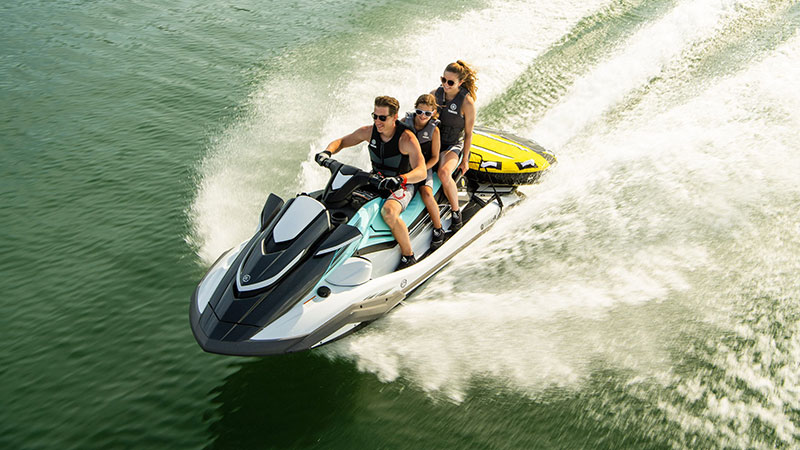Choosing your first new Jet Ski can be difficult because you will initially get conflicting advice on each of the three brands – Sea-Doo, Yamaha, and Kawasaki.
Whichever showroom you walk into, sales representatives will predictably say the brand they sell is the best.
On social media it can be hard to distinguish misinformation from good advice.
Most people recommend the ski they own. Few people have owned multiple brands in short succession or from the same era.
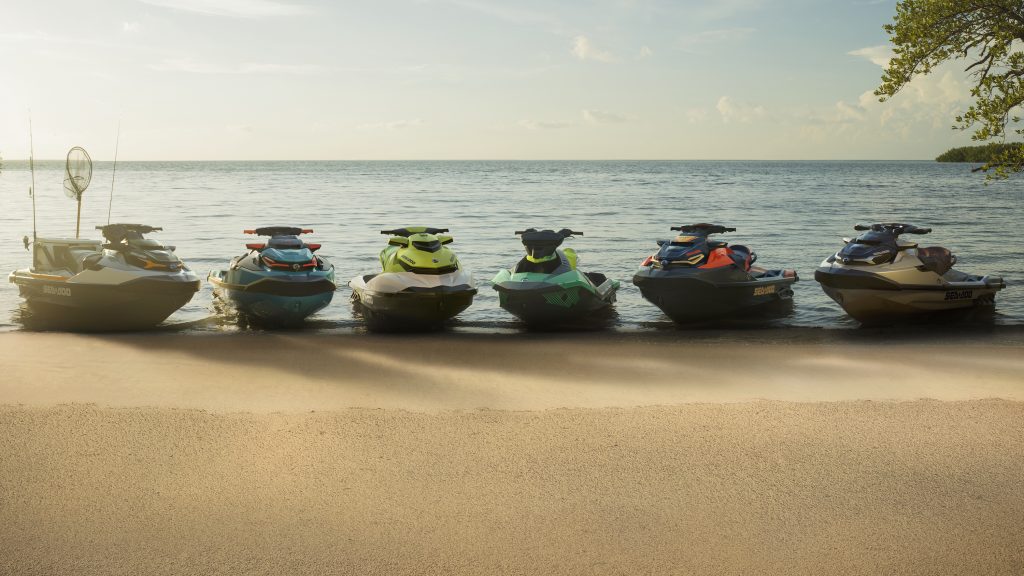
It’s worth noting customer experiences can vary because of the features and traits of each watercraft – and because of differences in dealer service and warranty support.
When it comes to choosing between Sea-Doo, Yamaha or Kawasaki, all three brands have pros and cons. No-one makes the perfect watercraft. But they all deliver huge amounts of fun, and are better at some things than others.
To learn about the weaknesses, faults, and shortcomings of each Jet Ski brand – based on our research talking to experts representing all three companies – click here for our “myth busters” report.
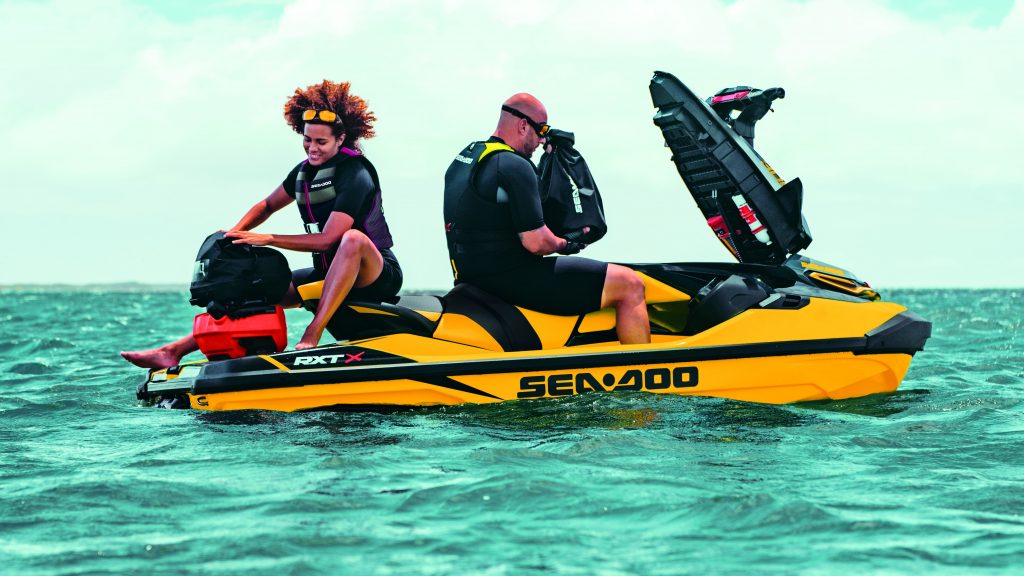
Before we run through our Top 10 list of Jet Skis for those who are new to the sport, here are some basics that might be helpful.
In Australia, long waiting times are expected for next year’s new Jet Skis due to severe stock shortages.
Click here for our recent story on when 2022 Jet Skis are due to arrive in Australia.
Warranty coverage varies across all three Jet Ski and personal watercraft brands.
As this article was published in September 2021, in Australia Sea-Doo has two-year coverage, Yamaha has three-year coverage, and Kawasaki has industry-leading five-year coverage.
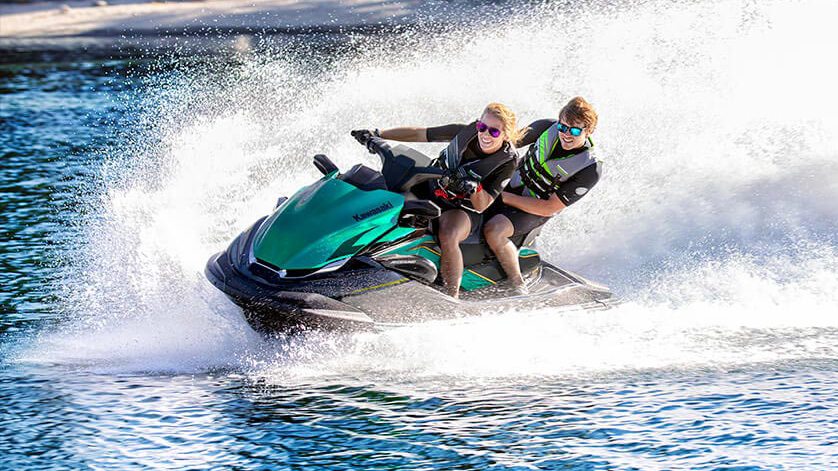
In addition to their published warranty periods, Jet Skis are covered under Australian Consumer Law.
However it’s worth noting out-of-warranty claims are defined by fair and reasonable wear and tear – and fair and reasonable use – which are open to interpretation.
When assessing warranty claims, all three brands look at the service history of the craft; most Jet Skis have service intervals of 50 engine hours or 12 calendar months, whichever comes first.
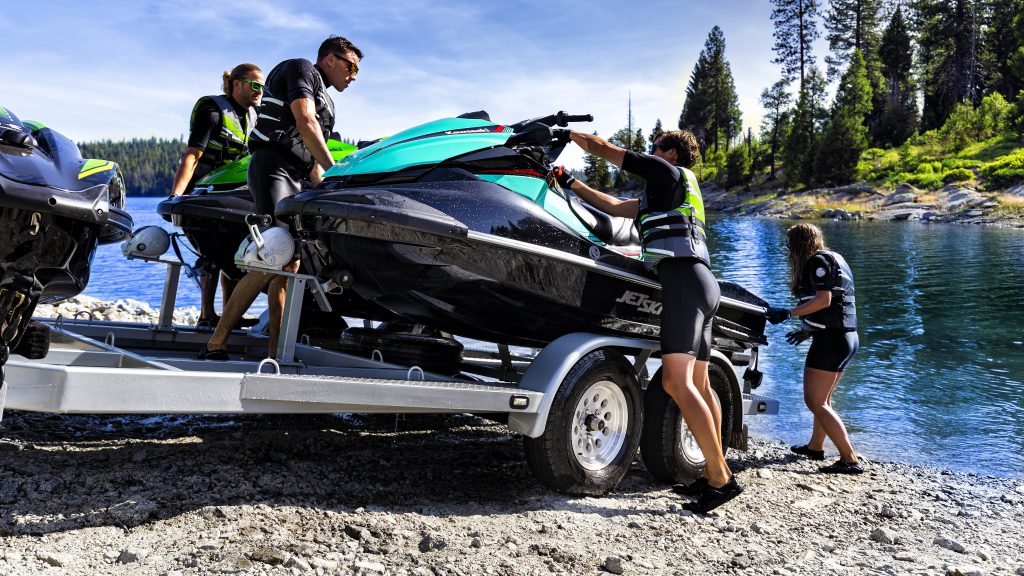
A well-maintained ski – with verification stamps in the logbook or on the workshop’s computer file – will have a better chance of a warranty claim being honoured.
Some customers get their craft serviced every six months – at the start and the end of each riding season – rather than 12 months, to ensure it’s well maintained.
Although our Top 10 list focuses on new Jet Skis, this story we published earlier provides tips on buying a used personal watercraft.
The next thing you need to know when buying your first Jet Ski is that there are three main sizes of personal watercraft: small, medium, and large.
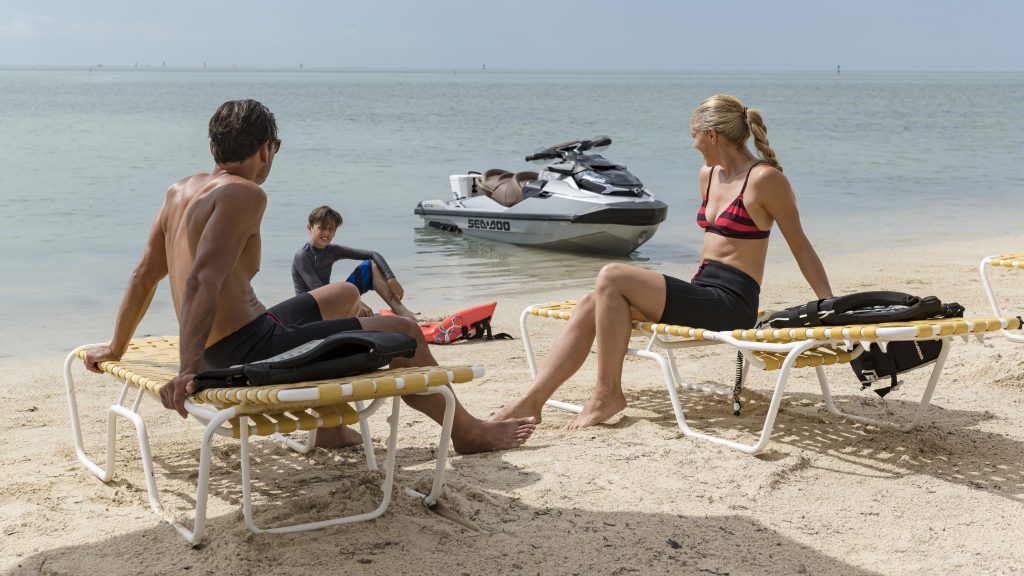
All three sizes are available as three-seaters, but bigger is better if you plan to ride with the family or as a couple.
More power makes it easier to tow a tube, though we wouldn’t recommend a supercharged Jet Ski first time out.
Non-supercharged Jet Skis are plenty fast-enough and will help you get into the groove. (That said, most models listed below have supercharged equivalents, if you feel the need for even more speed).
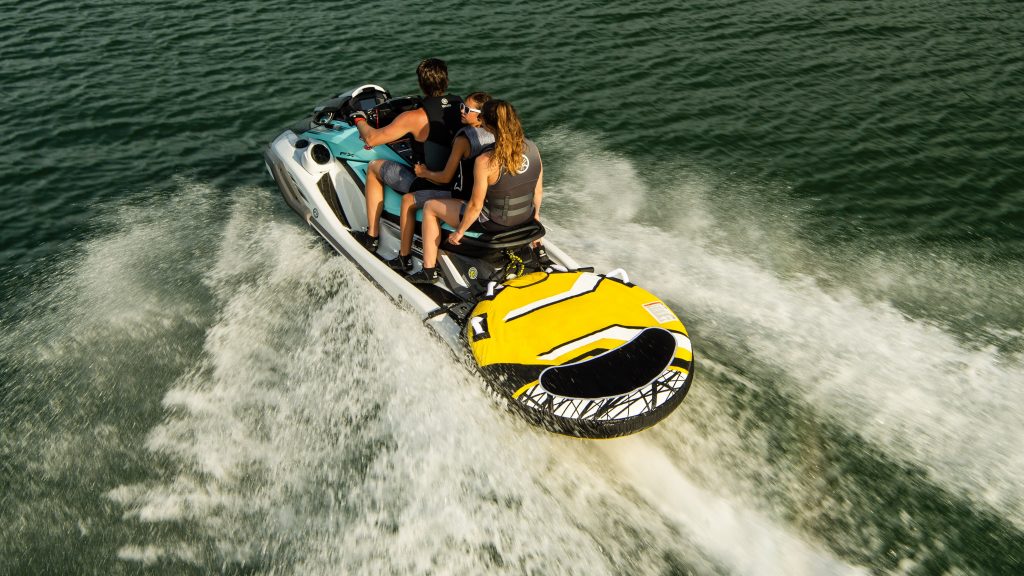
The other advantage of non-supercharged Jet Skis is fuel-efficiency.
All Jet Skis and personal watercraft are thirsty by car standards, but supercharged Jet Skis use up to 30 per cent more fuel than their non-supercharged Jet Ski equivalent.
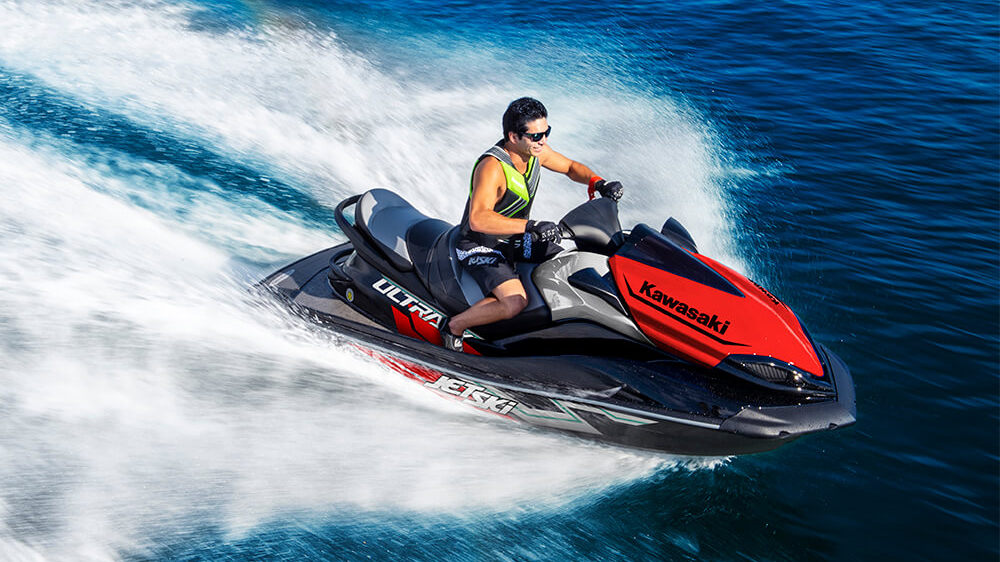
In case you’re wondering, all modern Jet Skis and personal watercraft run on regular unleaded or premium unleaded petrol, from the same petrol bowsers used for cars. The days of smokey two-strokes are long gone.
In this list below we have selected our Top 10 Jet Skis and personal watercraft for those who are new to the sport – across a range of sizes, power outputs, and price ranges.
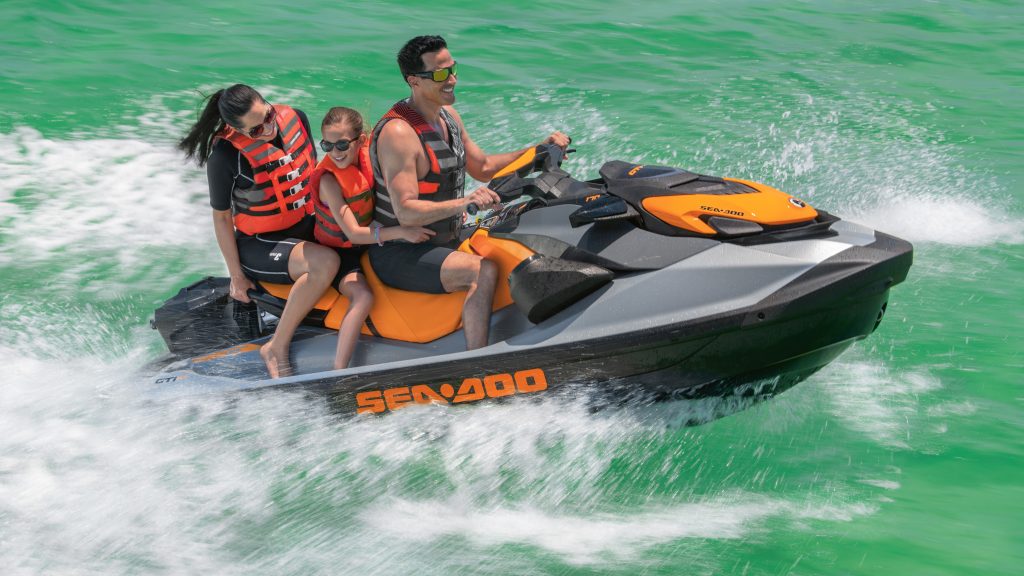
The cheaper and smaller Jet Skis listed here have less brutal acceleration and top speeds around the 75 to 80km/h mark. Dearer and larger Jet Skis listed here tend to top out at about 90 to 100km/h.
These speed estimates are academic because rider weight, fuel load, and water conditions all affect acceleration and cruising speed.
No matter which you choose, every one of the Jet Skis listed here delivers plenty of fun.
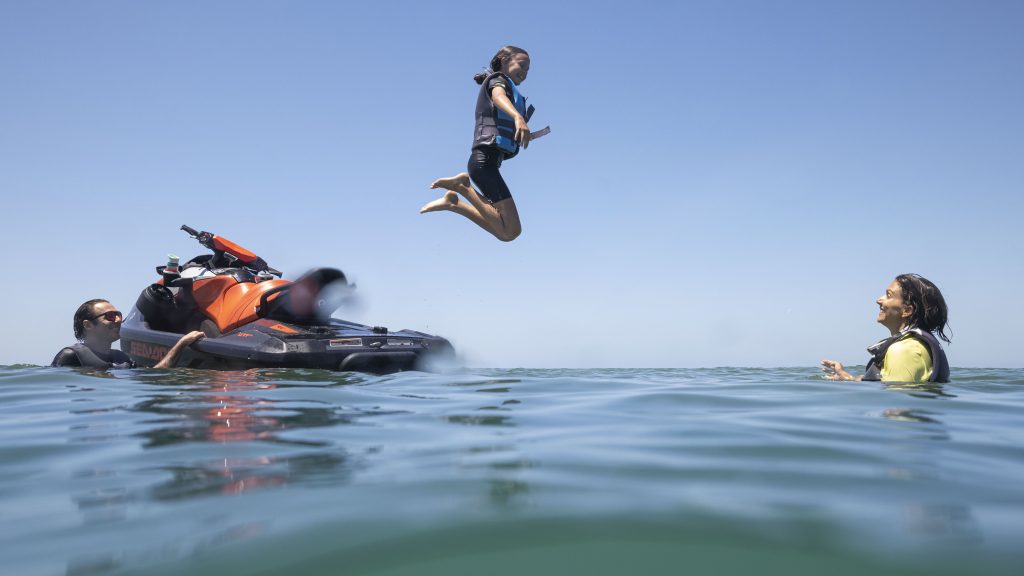
We’ve ranked each of our Top 10 choices via category and price – rather than attempting to select them in order of preference, because every buyer has unique needs.
A short note: all prices listed here exclude registration and the cost of a trailer, which varies depending on the fees in each Australian state, and the quality of the trailer.
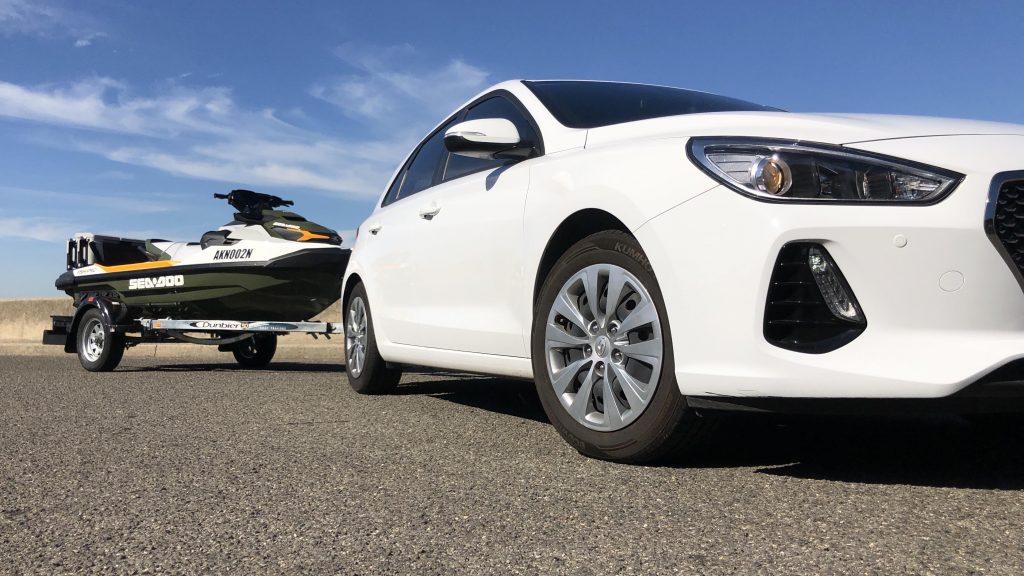
In general, budget on adding about $2000 to $2500 to these prices so you’re ready to “tow-away” with no more to pay.
One of the many great things about owning a Jet Ski is that they can be towed with small cars, so you don’t necessarily need a heavy-duty ute. Here’s a list of some of the small cars that can tow.
Top 10 new Jet Skis for 2022 if you’re new to the sport:
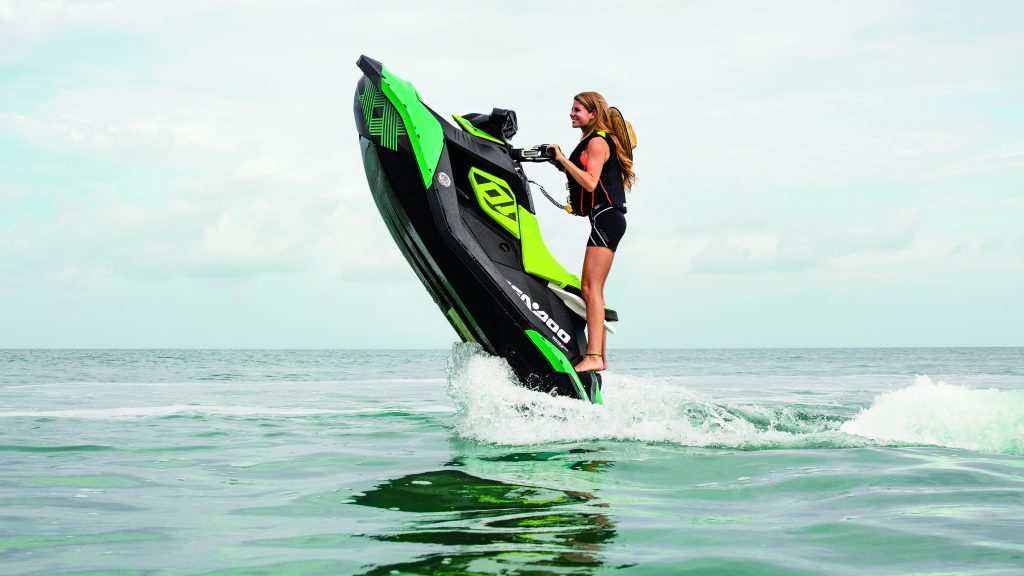
Sea-Doo Spark and Sea-Doo Spark Trixx (small)
2022 price range: $8769 to $12,969 (excluding trailer and registration)
Engine: 900cc three-cylinder
The Sea-Doo Spark and Sea-Doo Spark Trixx are a great way into the sport.
The starting price of $8769 (excluding trailer and registration) may seem attractive, but then you realise it’s only a two-seater, doesn’t include a reverse trigger, and only has a 60hp motor, the lowest output in the class.
Which is why many customers get walked up to the next model which starts from $12,469 (excluding trailer and registration). That comes with a 90hp motor, three seats, and a reverse trigger.
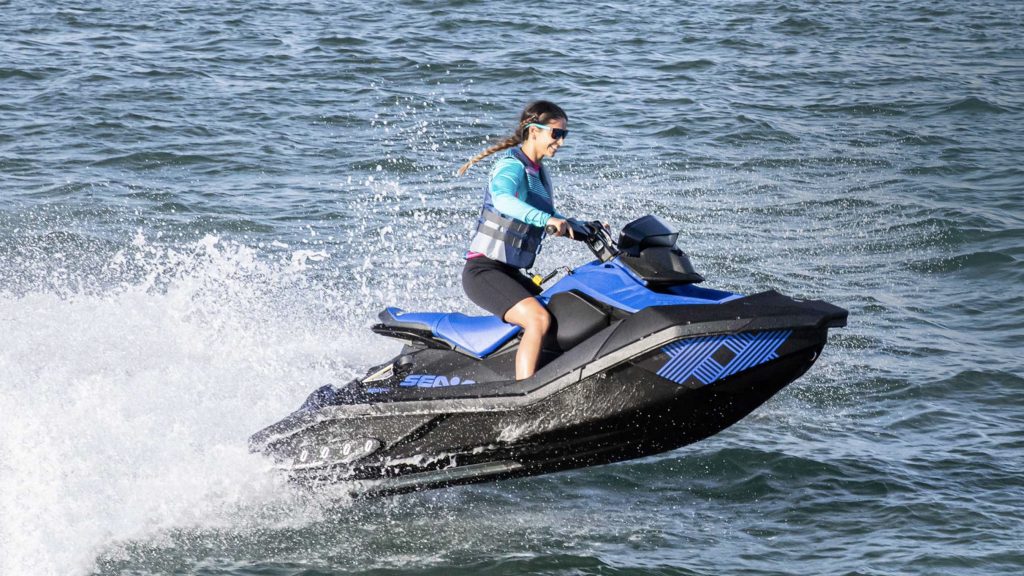
From there you can climb to the Trixx, which has rear step wedges and the jet pump nozzle is adjustable at the press of a button, which means you can ride it on the tail (the on-water equivalent of a wheelie). It’s easy to master, even in novice hands.
A two-seat Sea-Doo Spark Trixx is a popular choice as it includes “wheelie” mode, a 90hp engine, reverse trigger, and costs $12,069 (excluding trailer and registration). The three-seater Sea-Doo Spark Trixx costs $12,969 (excluding trailer and registration).
A removable speaker system (with pretty decent sound) that connects via Bluetooth is a $1000 option on both Trixx models.
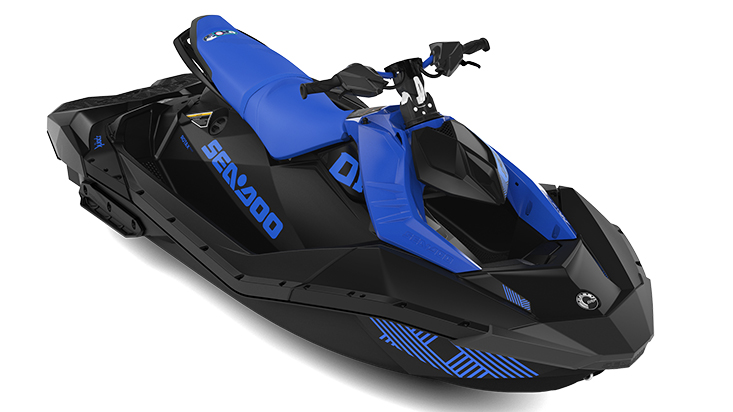
Pros: Economical and fun – and easy and forgiving to ride. Great way to get into the sport.
Cons: It’a a wet ride (if you’re trying to stay dry on the water, a Jet Ski is not for you), storage space is limited, and the fuel tank is small (30 litres). Better suited to flat water. Not everyone is a fan of the plastic deck and hull, which can be difficult to repair (but at least it’s easier to keep clean than fibreglass).
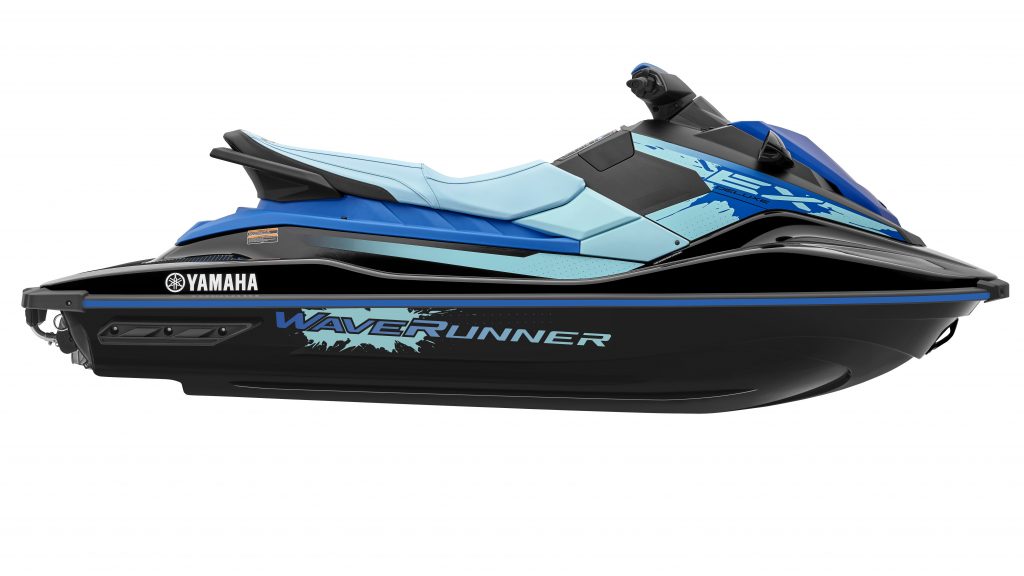
Yamaha EX and EX Deluxe (small)
2022 price range: $8799 to $11,699 (excluding trailer and registration)
Engine: 1050cc three-cylinder
As with the cheapest Sea-Doo Spark model, the most affordable version of the Yamaha EX is a bare bones proposition. It lacks a reverse lever and one can’t be added afterwards.
That means it’s a big step up from the base model Yamaha EX at $8799 (pictured below in white), to the Yamaha EX Deluxe (pictured above in black) at $11,699 (both prices excluding trailer and registration).
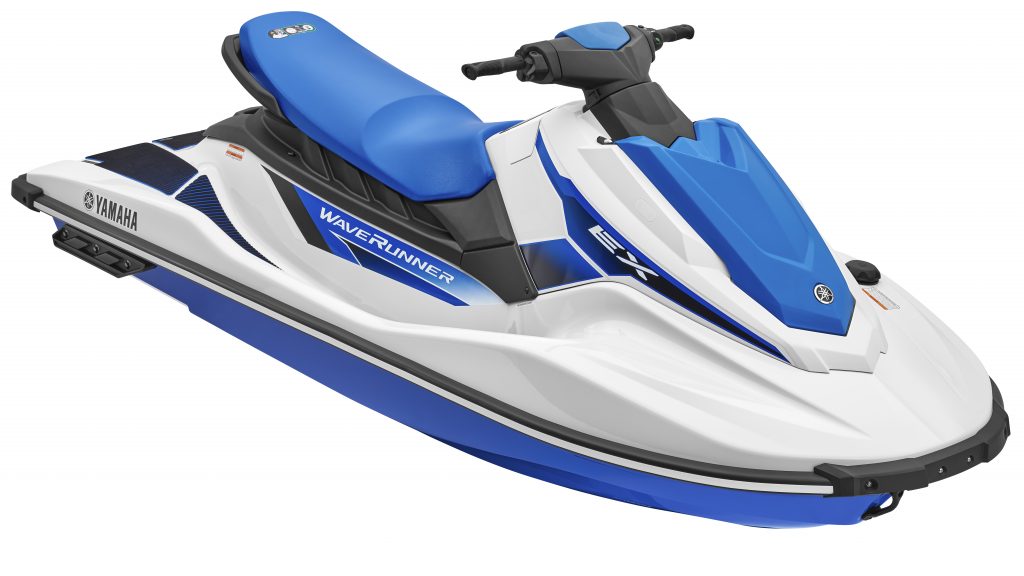
In this price range $2900 may seem steep but we reckon it’s worth having the convenience and safety of the reverse trigger, side mirrors, and rear boarding step.
Yamaha doesn’t quote a power figure for most models, but the EX is powered by a willing and economical 1050cc three-cylinder estimated to have a 90hp output.
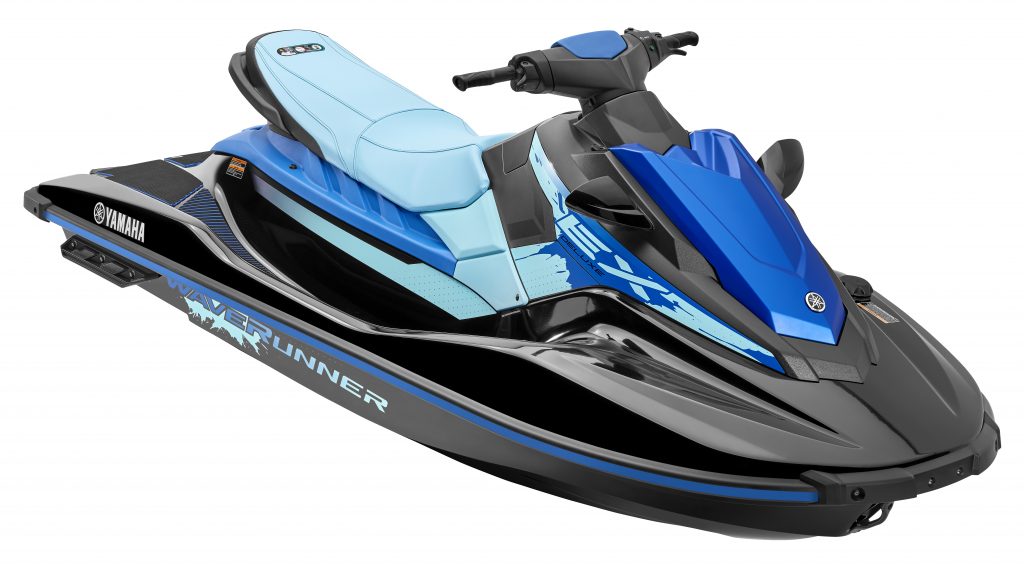
Pros: More precise to ride than the Sea-Doo Spark and just as much fun. Durable SMC fibreglass hull, large rear deck makes it easy to reboard, comfortable seat, more storage than a Sea-Doo Spark. The economical engine and 50-litre fuel tank should deliver endless fun.
Cons: Can’t perform the on-water equivalent of “wheelies” (if this is a must, consider the dearer Yamaha EX-based JetBlaster which can get more air, but is not designed to get vertical). Optional audio speakers not available in Australia. Better suited to flat water than rough chop.
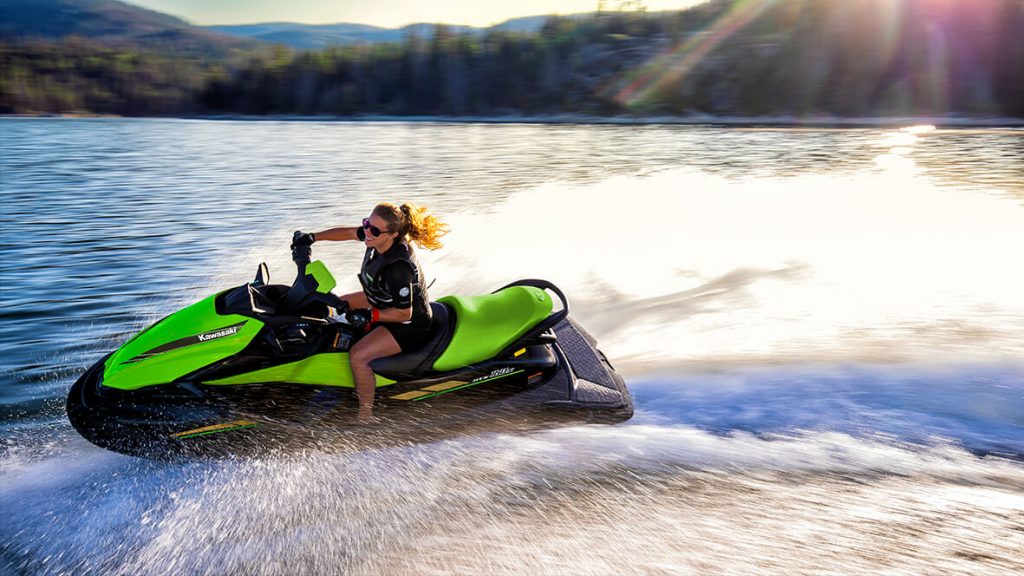
Kawasaki STX 160 (medium)
2021 price range: $14,999 to $16,799 (excluding trailer and registration)
Engine: 1.5-litre four-cylinder
For now, Kawasaki does not have a rival to the Sea-Doo Spark and Yamaha EX series.
The Kawasaki STX 160 is the cheapest ticket into the Kawasaki range. As a medium-size Jet Ski the Kawasaki STX 160 is bigger than the Sea-Doo Spark and Yamaha EX.
In Australia there are two models, the Kawasaki STX 160X without speakers ($14,999 excluding trailer and registration) and the Kawasaki STX 160LX with speakers and tiered seating ($16,799 excluding trailer and registration).
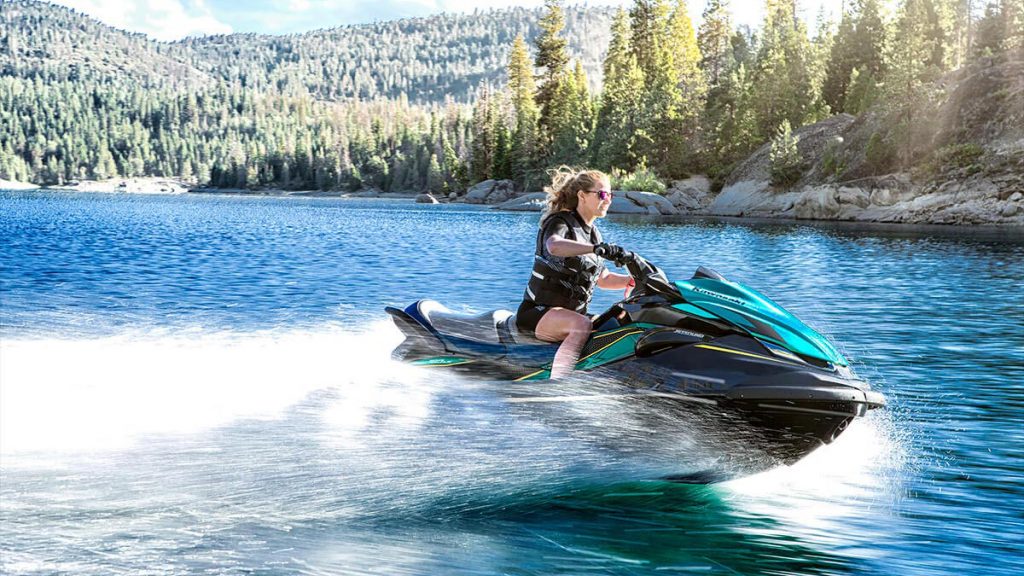
Both models are otherwise the same (except for colours), with good storage on the top deck (including in the nose and, in the centre console, a waterproof compartment for phones) and a comfortable riding position.
There is plenty of power on tap (the same engine is also used in the next size up Kawasaki Jet Ski).
The durable SMC fibreglass hull is comfortable in flat water or in medium chop. The 78-litre tank means it will last all day for most people.
The Kawasaki STX 160 is a great size for first timers who want a craft that’s stable and also easy to manoeuvre. The only downside is the clumsy reverse lever, which takes practice and is not as fast or as intuitive to use as a reverse ‘trigger’ on a handlebar (as per Sea-Doo and Yamaha).
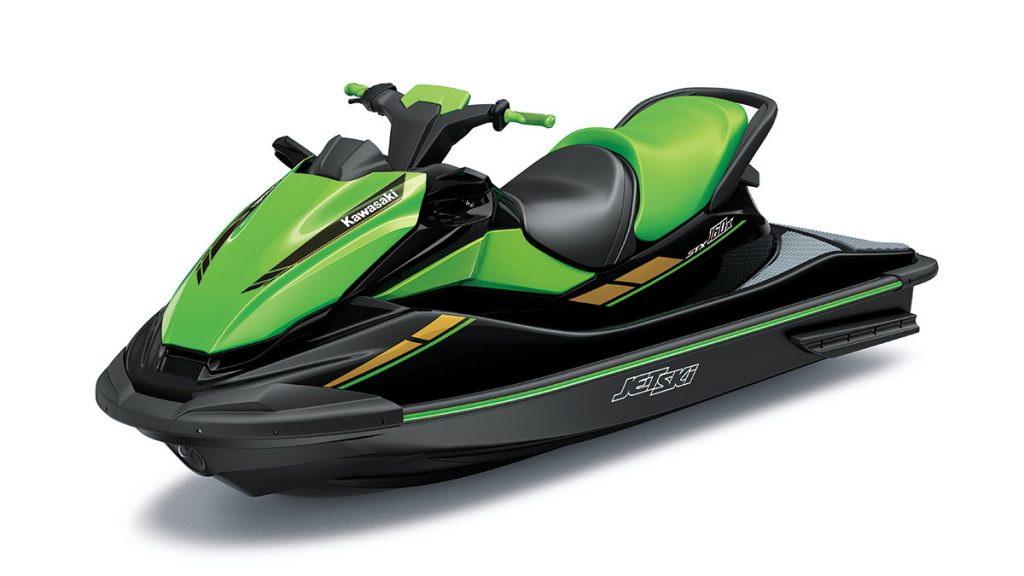
Pros: Strong and proven hull, excellent storage, long riding range thanks to the 78-litre tank and non-supercharged engine.
Cons: No trim adjustment, so the ride is wetter than it needs to be. There is a clumsy and awkward reverse lever rather than a reverse trigger (favoured by Sea-Doo and Yamaha).
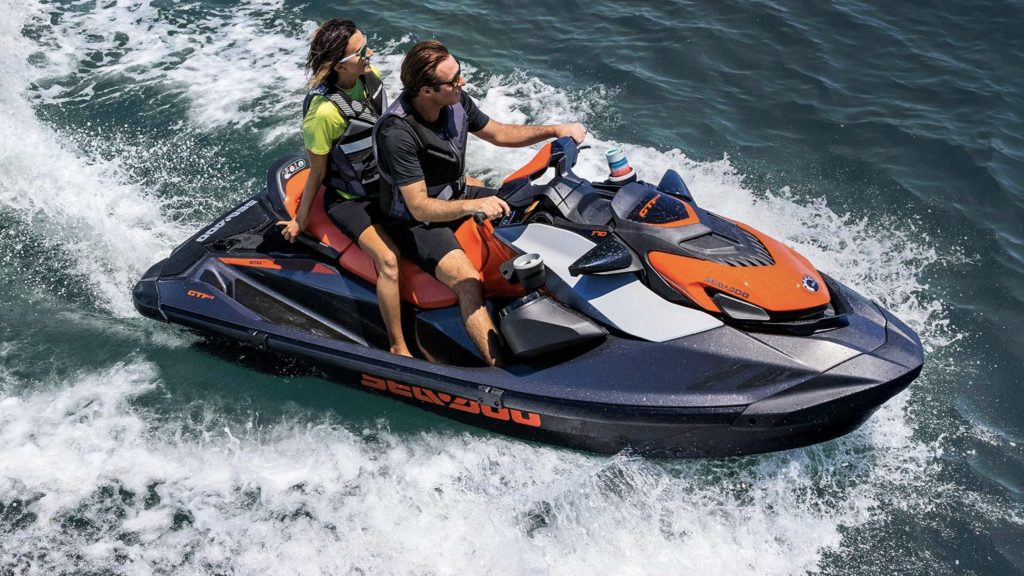
Sea-Doo GTI SE 170 (medium)
2022 price range: $17,989 (excluding trailer and registration)
Engine: 1630cc three-cylinder
The Sea-Doo GTI SE 170 is one of the most under-rated watercraft in the industry.
This mid-size three-seater model is priced at a sweet spot in the market, has good storage space, and features that are often optional extras at this price point.
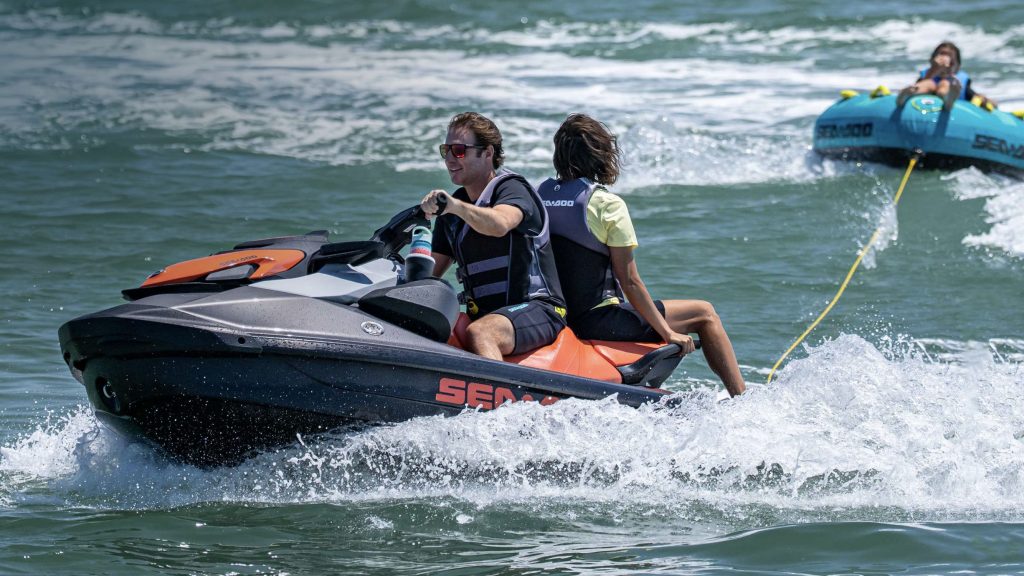
Standard equipment includes trim adjustment (to bring the nose up or down according to riding conditions and fuel load), a rear boarding ladder (optional on many Sea-Doos but standard on most other watercraft) and the option of a speaker system.
With a 60-litre fuel tank, an economical 1630cc three-cylinder engine, and a lightweight plastic hull, you’re likely to be able to spend a day on the water without needing to refuel. (However, as with all skis – supercharged or non-supercharged – towing a tube dramatically increases fuel use).
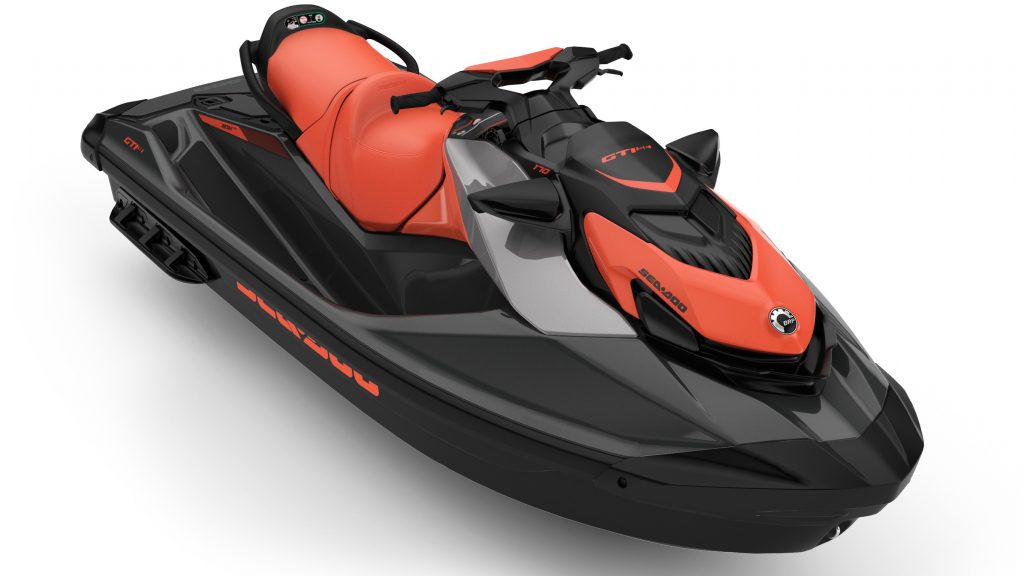
For 2022, the Sea-Doo GTI SE 170 is also available with Sea-Doo’s proprietary debris removal tech. Sea-Doo says it has overcome the gremlins that affected early examples of this tech. Read the latest update to Sea-Doo’s IDF debris removal system here.
We would choose the model without IDF to avoid complications and to save money.
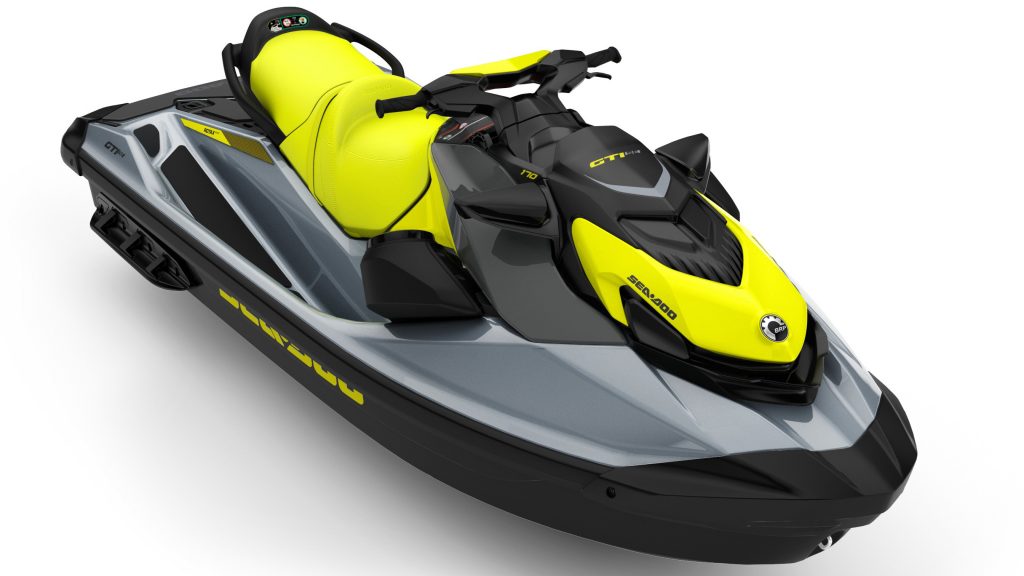
Pros: Great size for the family yet still easy to manoeuvre. Plenty of power for this size of craft. Good storage. Fair price point.
Cons: Not everyone is a fan of the plastic hull material for repairability (but at least it is easy to clean). Better suited to flat water and medium chop rather than rough conditions.
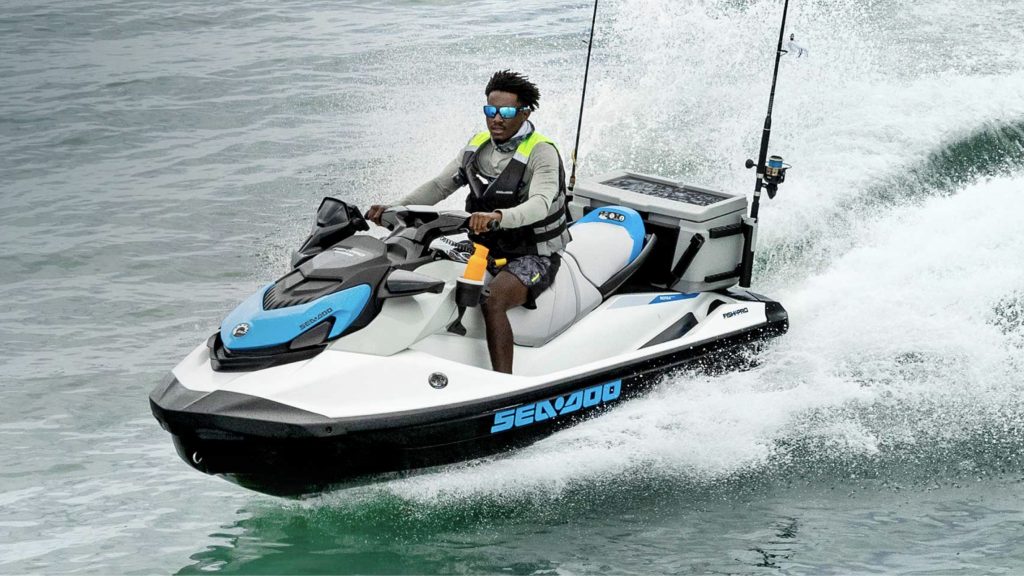
Sea-Doo Fish Pro Scout 130 (medium)
2022 price range: $19,609 (excluding trailer and registration)
Engine: 1630cc three-cylinder
Based on the Sea-Doo GTI series (mentioned above in our previous pick), the Sea-Doo Fish Pro Scout is new for 2022.
Sea-Doo has added many of the accessories from the original and larger model, the Sea-Doo Fish Pro 170, and created a new entry point in the range.
The 1630cc engine is the same fitted to the GTI SE 170 mentioned above and the Sea-Doo Fish Pro 170 we will cover off later in this list, however it is detuned to 130 horsepower rather than 170 horsepower.
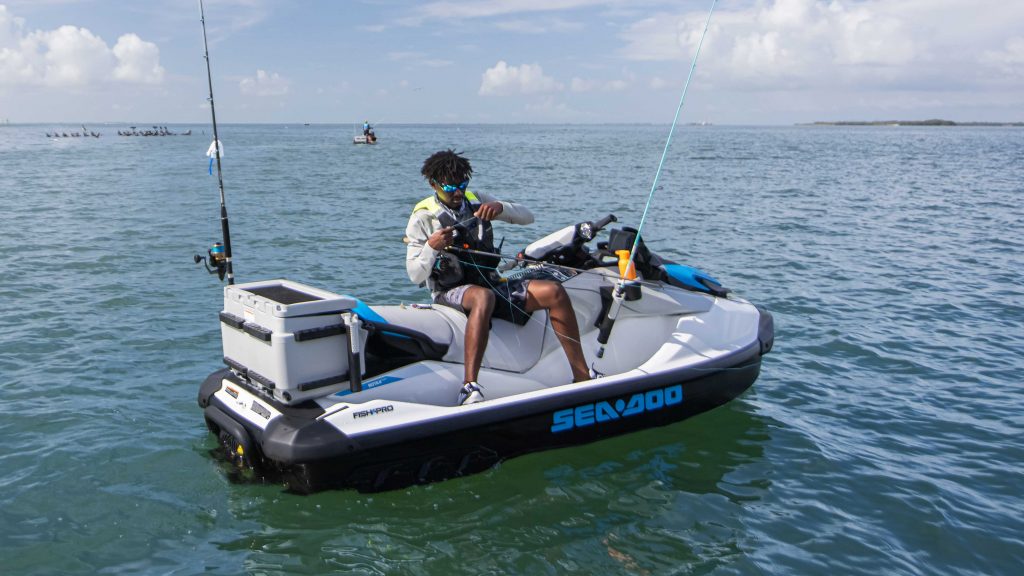
That’s still enough power for this model, which is designed for flat water fishing in rivers and lakes.
Based on the Sea-Doo GTI series the Sea-Doo Fish Pro Scout comes with a Garmin 6-inch fish finder and GPS unit (which replaces the right side-mirror), three fishing rod holders, a 51-litre cooler box, trolling mode, and Sea-Doo’s IDF debris removal system.
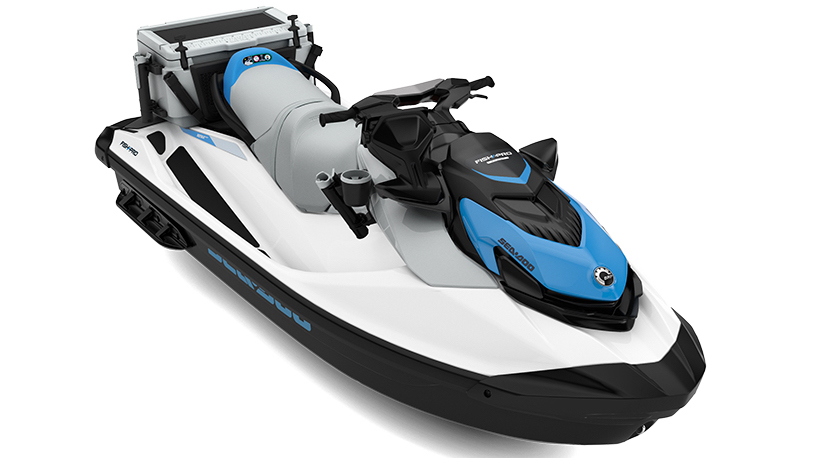
Pros: ‘Turn-key’ solution for fishing enthusiasts who don’t need the top-of-the-range model. Cooler box can be used to store ice for drinks and food if you just want to use it for picnics.
Cons: This craft is better suited to calm waters with this set-up, though it can handle medium chop if the wind picks up. Lacks the extended rear deck and side steps on the top deck that are standard on the dearer and bigger Fish Pro Sport and Fish Pro Trophy.
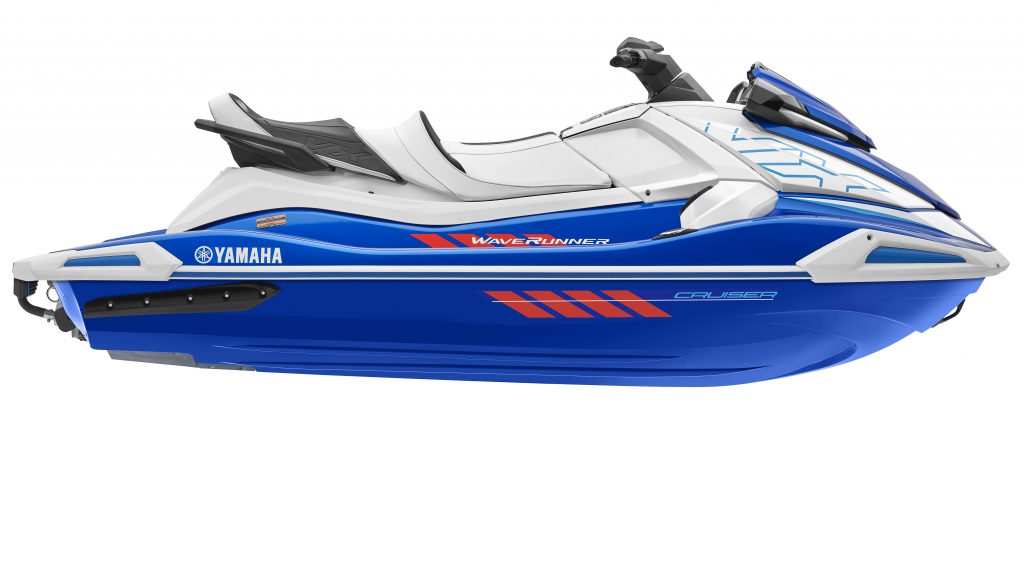
Yamaha VX Cruiser 1050 (medium)
2022 price range: $17,799 (excluding trailer and registration)
Engine: 1050cc three-cylinder
This is also one of the most under-rated models in the entire Jet Ski and personal watercraft market.
For 2022, Yamaha has equipped this model just right, with factory-fitted speakers, tiered seating, and docking cleats as standard.
Storage in the centre console and the nose of the craft are fair for this mid-size three-seater.
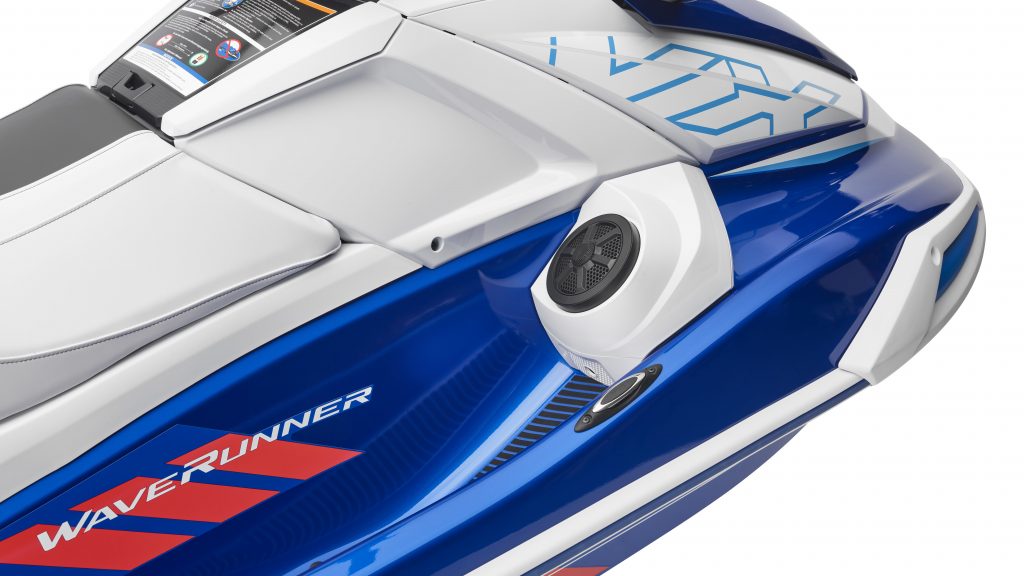
The hull combines the best of both worlds. It’s made from durable SMC fibreglass yet moulded to the same shape as Yamaha’s race-winning GP1800R SVHO hull.
It’s a comfortable and easy craft to manoeuvre, but also has precise handling. The only thing on our wish list would be the addition of adjustable trim (to bring the nose up or down depending on conditions and fuel load). Sadly it’s not yet available on this model, so one step short of perfection then.
With a super-economical 1050cc three-cylinder engine and a generous 70-litre tank, the Yamaha VX Cruiser is destined to run all day.
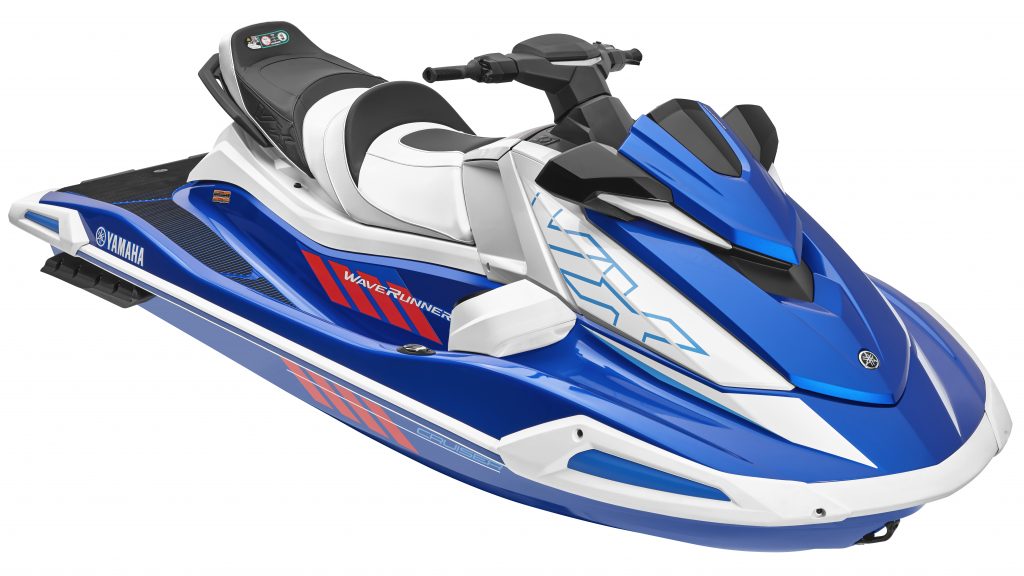
Pros: Excellent fuel economy and riding range. Easy to manoeuvre. Factory-fitted speakers.
Cons: No trim adjustment on this model. It would be the finishing touch on an otherwise excellent craft.

Kawasaki Ultra LX (large)
2021 price: $16,299 (excluding trailer and registration)
Engine: 1.5-litre four-cylinder
The Kawasaki Ultra platform has been around in this guise for 14 years. But, as the saying goes, if it aint broke don’t fix it.
Because the Kawasaki Ultra LX has a durable SMC fibreglass hull, it’s a heavy beast.
This makes it thirstier than many of its rivals but it also means it cuts through chop better than most other Jet Skis.
It has a massive two-tier storage area in the nose and a modest centre console. The riding position is low, which is good for tight turns, but you do get wet.
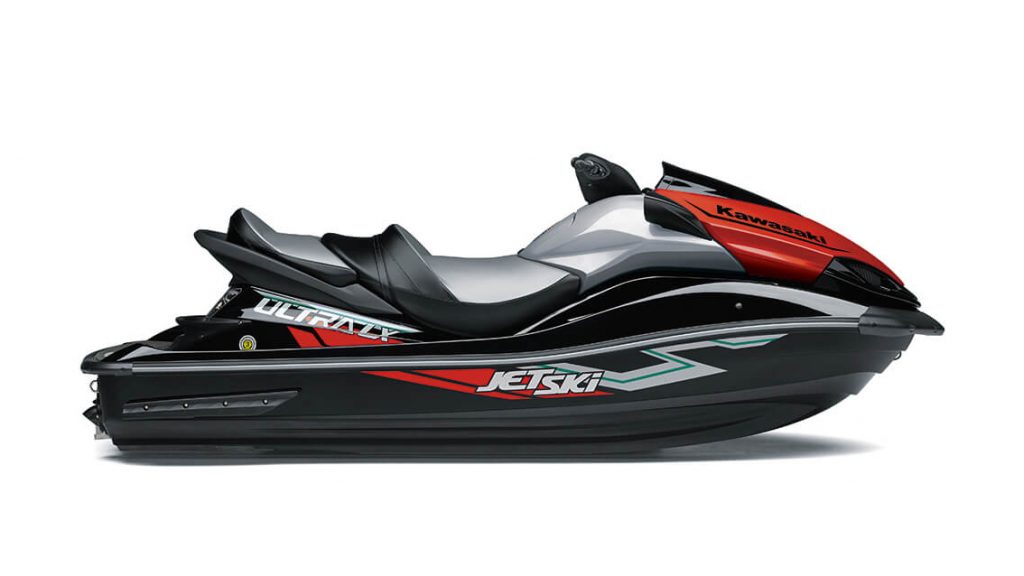
Unfortunately there is no trim adjustment on this model (to raise or lower the nose according to conditions and fuel load).
And there is a large and clumsy reverse lever rather than the convenient and user-friendly reverse trigger on the handlebar favoured by Sea-Doo and Yamaha.
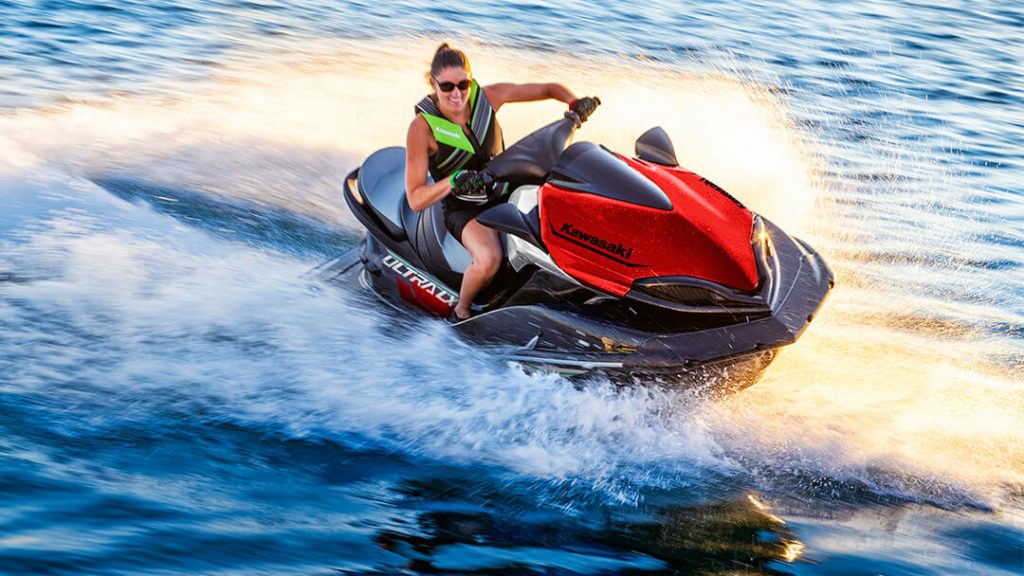
Overall, the Kawasaki Ultra may be getting on in age, but it’s a sturdy machine and the preferred choice of ultra-distance Jet Ski riders.
A 2017 Kawasaki Ultra was used to lap Tasmania (in 2019) and mainland Australia (in 2020 and 2021), while a trio of Kawasaki Ultras were used to cross between Victoria and Tasmania (in 2018). A Kawasaki Ultra was also ridden from Melbourne to Brisbane in 2017.
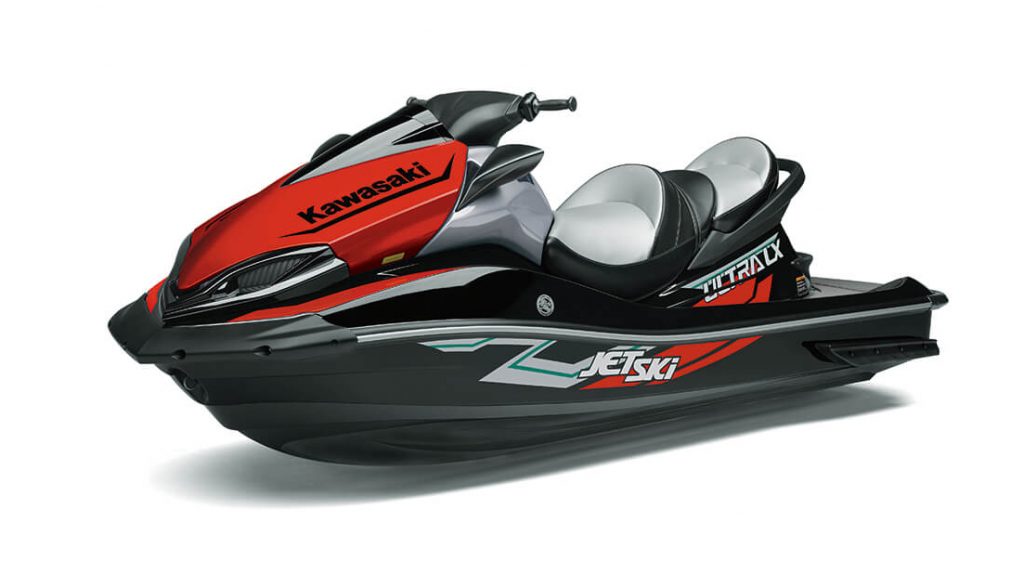
Pros: Durable and stable hull. Massive front storage area and 78-litre petrol tank. Good in medium- to rough-chop (though nothing is ‘comfortable’ in truly rough conditions).
Cons: No trim adjustment, no reverse ‘trigger’, small rear deck, centre console could be bigger. Handlebars might be too far rearward if you like to stand while riding.
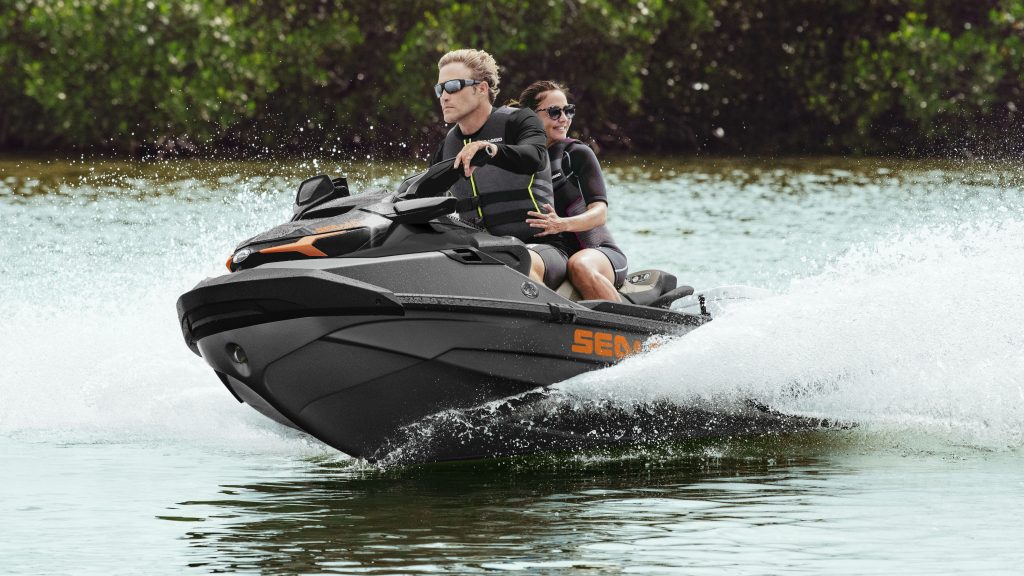
Sea-Doo GTX 170 (large)
2022 price range: $20,809 to $22,409 (excluding trailer and registration)
Engine: 1630cc three-cylinder
Another under-rated and often overlooked Jet Ski because so much of the focus on social media is about supercharged models, the Sea-Doo GTX 170 blends Sea-Doo’s user-friendly full-size three-seat ST3 deck and hull with the economical 1630cc 170-horsepower three-cylinder engine.
It’s the same platform that is the basis of the Sea-Doo Fish Pro Sport and Trophy editions – but without the add-ons for fishing (which can be added later). It’s also available in 230hp and 300hp supercharged configurations.
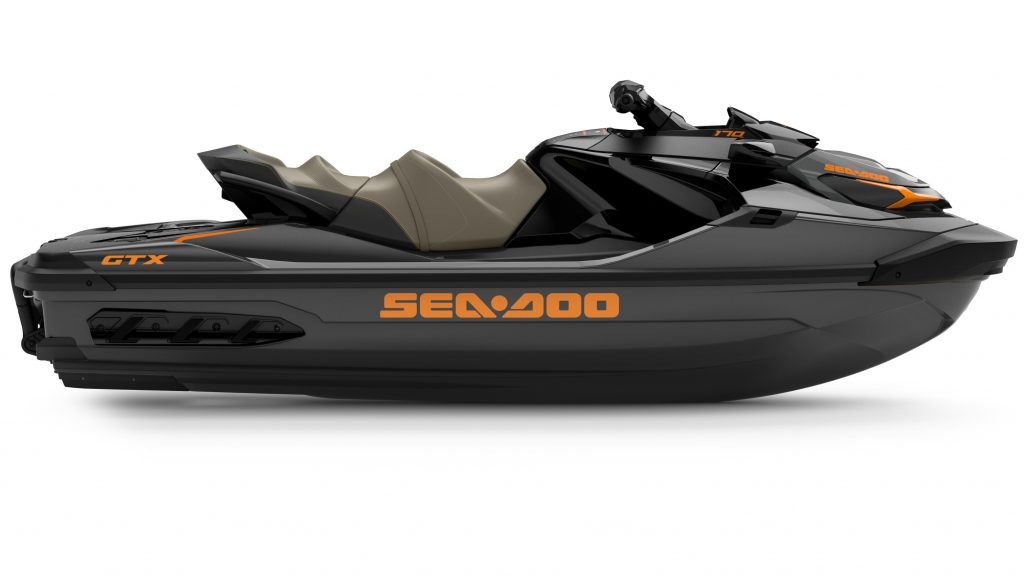
The Sea-Doo GTX 170 had a price bump for 2022 and there are now three versions offered in Australia.
The Sea-Doo GTX 170 is available without audio speakers ($20,809 excluding trailer and registration), with speakers ($21,809 excluding trailer and registration), and with speakers and IDF debris-removal tech ($22,409 excluding trailer and registration).
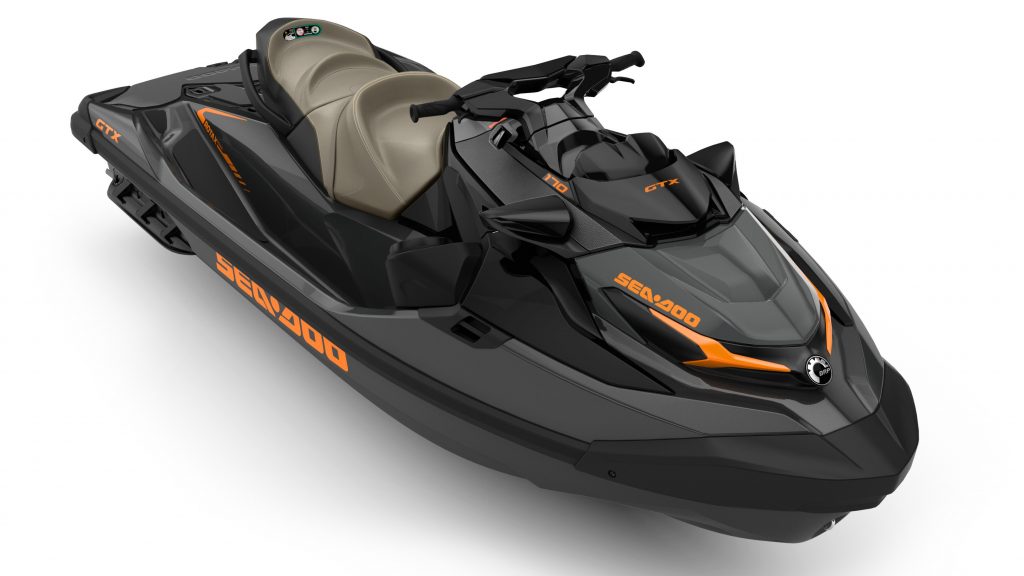
Pros: One of the most cleverly-designed and user-friendly Jet Skis on sale today (the lid to the front storage area lifts up with the handlebar console, so you don’t need to lean over them for access), comfortable riding position, large rear deck for optional accessories.
Cons: The large footwells can fill with water and make the craft unstable when stopped (fixed with a quick blast of the throttle). The ST3 hull is pretty good in medium to rough chop but its more upright nose means it ‘bow hunts’ in cross-chop. Not as good as the Yamaha FX in really rough conditions, not as agile as the Yamaha FX at low speeds in smooth conditions.
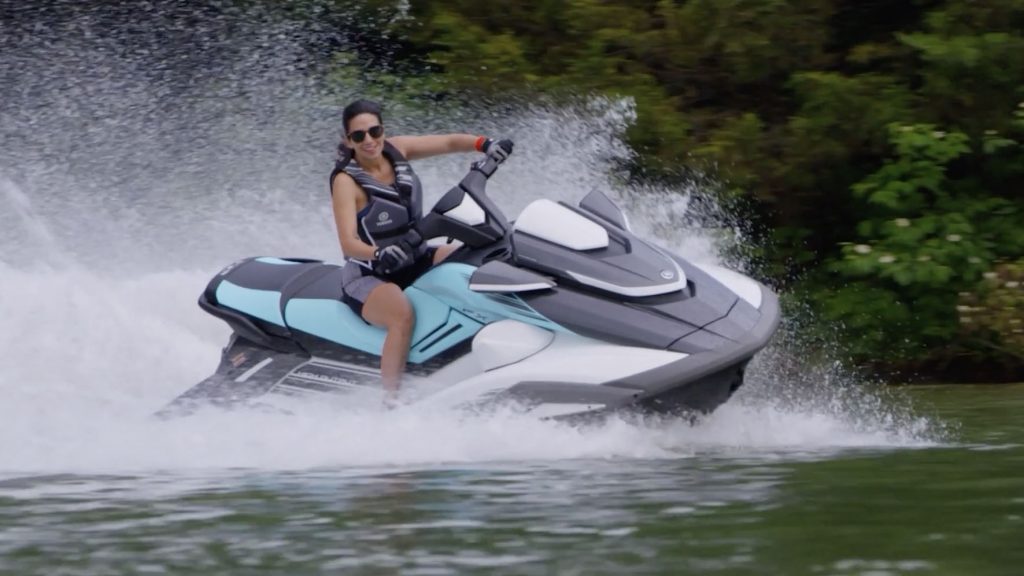
Yamaha FX HO (large)
2022 price range: $22,599 to $23,599 (excluding trailer and registration)
Engine: 1.8-litre four-cylinder
There are two models: the 2022 Yamaha FX HO ($22,599 excluding trailer and registration) and the Yamaha FX HO Cruiser ($23,599 excluding trailer and registration). There are also supercharged versions of this watercraft.
Aside from different colour and trim, the only differences between the two Yamaha FX HO models: the Cruiser gains tiered seating and docking cleats on the top deck.
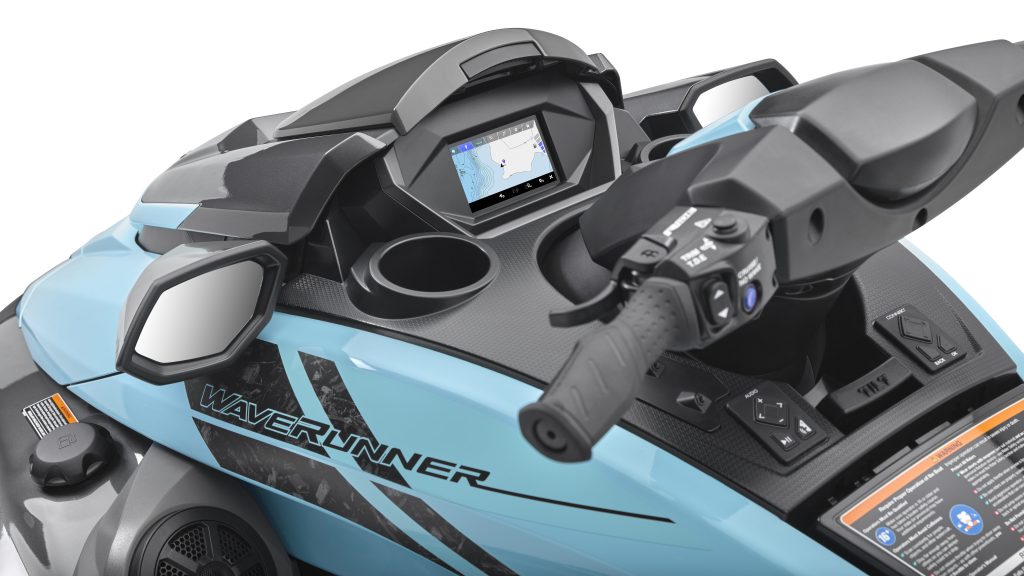
The Yamaha FX series has had a major makeover for 2022, now with a more durable hull made from SMC fibreglass (though the same shape as before), factory-fitted speakers on all models, and a new five-inch digital display with a high-resolution glass screen.
The infotainment system can be configured with maps or to make or take phone calls and text messages.
The 1.8-litre four-cylinder engine has plenty of grunt, though is slightly thirstier than the 1630cc three-cylinder in the similarly-sized Sea-Doo.
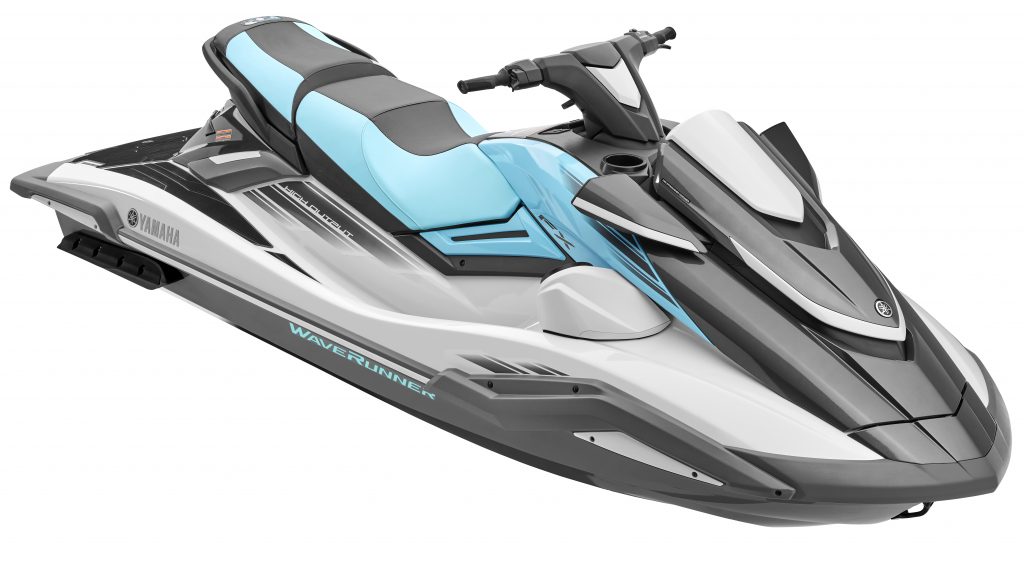
The Yamaha FX has good storage in the nose (though it can be difficult to tie it all down), and there’s now a dedicated space and charging capability for smartphones in the centre console.
The large, flat rear deck is designed for Yamaha’s new range of RecDeck accessories (though these optional-extra attachments are yet to be confirmed for Australia).
One of the Yamaha FX series biggest aces is its ability to cut through rough water. A favourite among ocean riders, it’s the best of the current breed when the going gets really tough. While earlier models were susceptible to hull damage, 2022 FX models onwards are constructed from a more durable hull material.
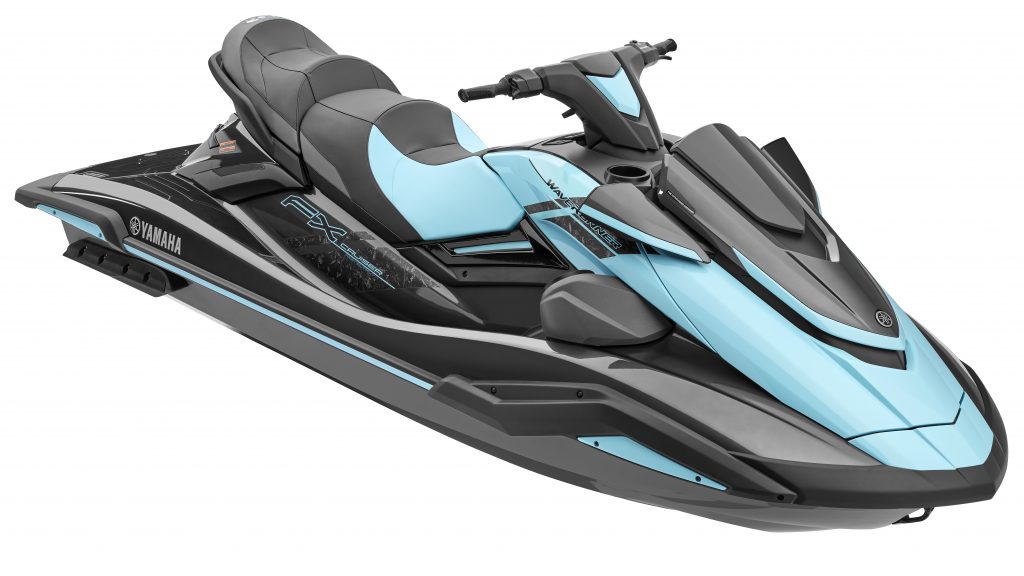
Pros: More tech, comfort, and convenience features than ever before, including navigation and smartphone integration. Durable SMC fibreglass hull. Cuts through chop, and has sharp handling in flat water too. Decent fuel range from the 70-litre tank (though the 1630cc Sea-Doo with a 70-litre tank has better mileage).
Cons: Non-supercharged FX HO models come with a five-inch display screen, it would have been nice for the dearer Cruiser model to come with the seven-inch cluster from the supercharged FX SVHO models. Fuel filler on the nose not ideal for on-water refuelling.
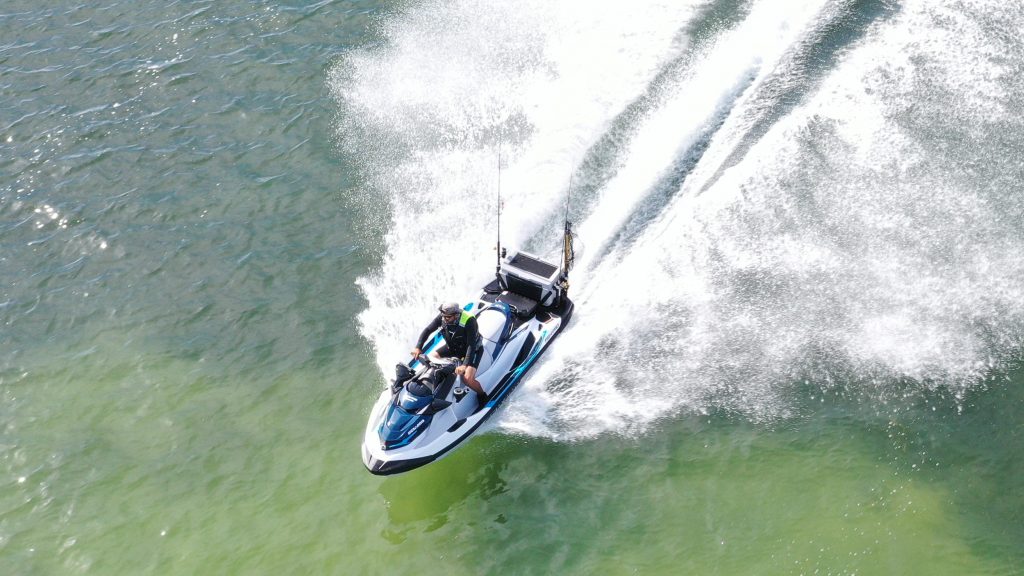
Sea-Doo Fish Pro 170 (large)
2022 price range: $22,709 to $27,309 (excluding trailer and registration)
Engine: 1630cc three-cylinder
After pioneering the fishing Jet Ski segment in late 2018 as a 2019 model year, the Sea-Doo Fish Pro took the industry by storm and created a new market.
The first ‘turn key’ factory-built personal watercraft dedicated to fishing is as popular today as when it was unveiled.
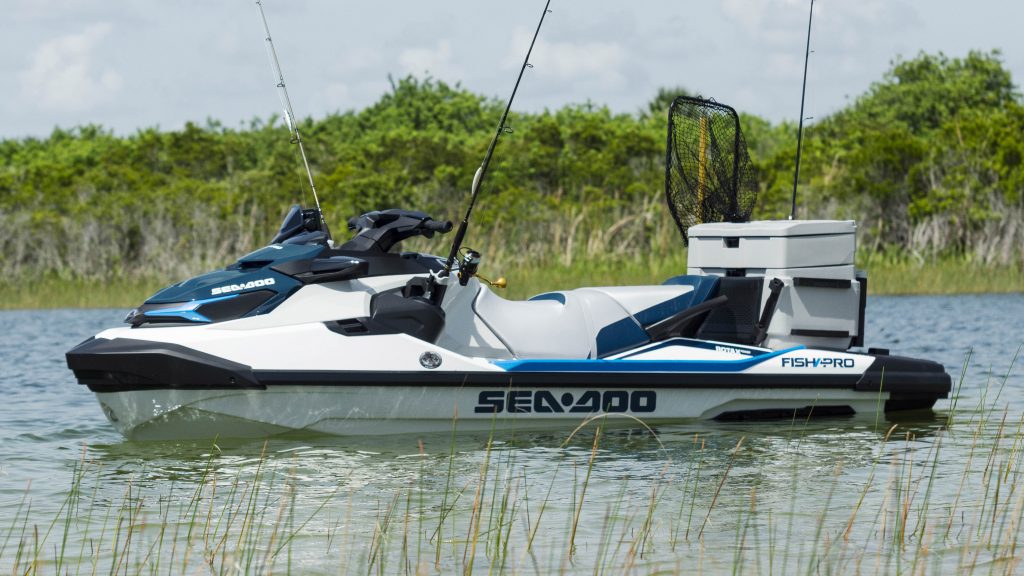
There are now three models, starting with the medium-size Sea-Doo Fish Pro Scout 130 ($19,609) mentioned earlier in this list, while the original full-size Sea-Doo Fish Pro 170 (pictured above and below) has been renamed Fish Pro Sport ($22,709).
In Australia for 2022 there are four versions of the Sea-Doo Fish Pro Sport.
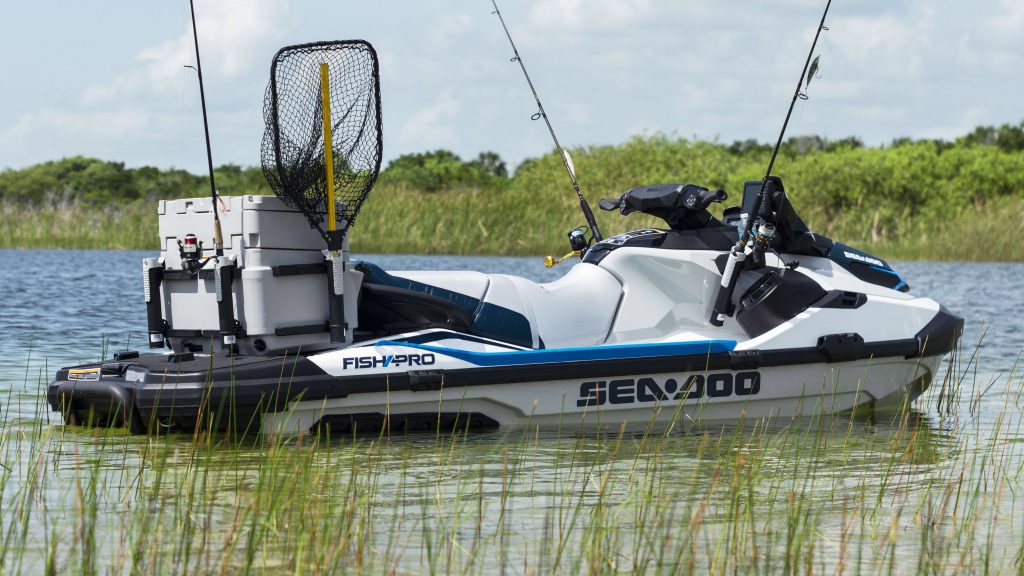
There is a standard edition ($22,709), a version with speakers ($23,709), another variant with IDF debris-removal tech ($23,309), and one with speakers and IDF debris-removal tech ($24,309).
Topping the line-up and new for 2022 is the Sea-Doo Fish Pro Trophy edition ($27,309 excluding trailer and registration as per all prices listed).
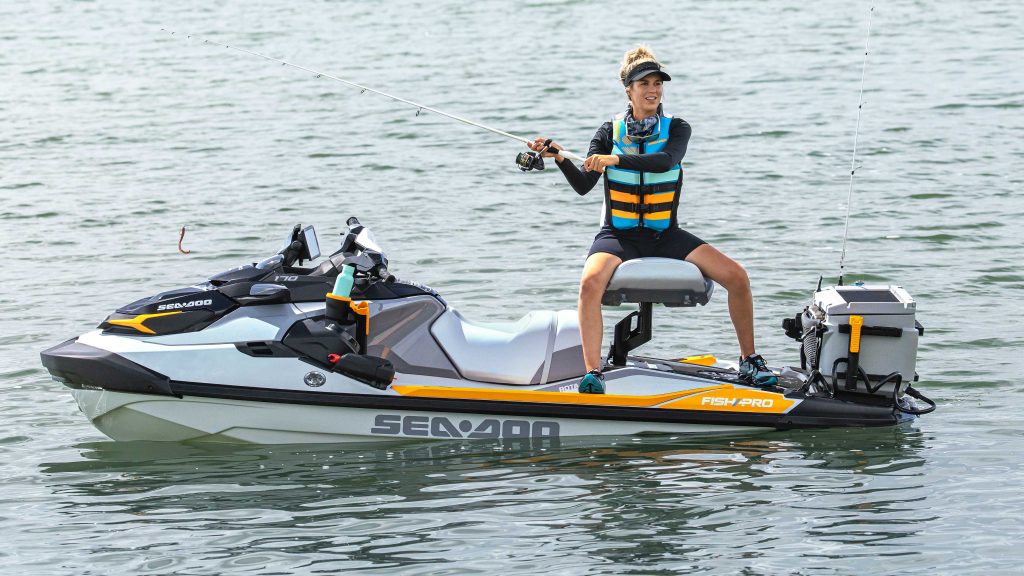
In addition to all the other Fish Pro goodies such as the 51-litre cooler box, rod holders, side steps, and rear deck extension, the Trophy comes with an even larger navigation screen and fish finder, and a hose to use seawater (or lake water) to transform the cooler box into a bait well or to clean the catch.
The Trophy edition is also available with accessories such as a pop-up seat and a claw anchor and holster (optional in Australia but standard in the US).
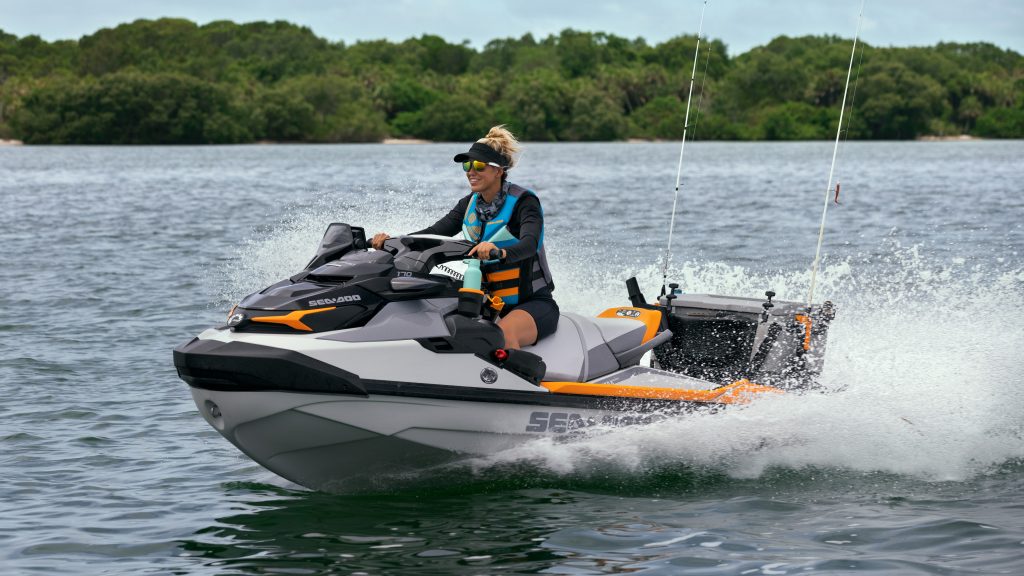
The Sea-Doo Fish Pro series – and in particular the Sport and Trophy models – is a triumph of industrial design, and has been developed by fishing enthusiasts for fishing enthusiasts.
The prices are starting to climb (along with their popularity), but the Fish Pro makes this list because you don’t need to be a pro to start out with one of these.
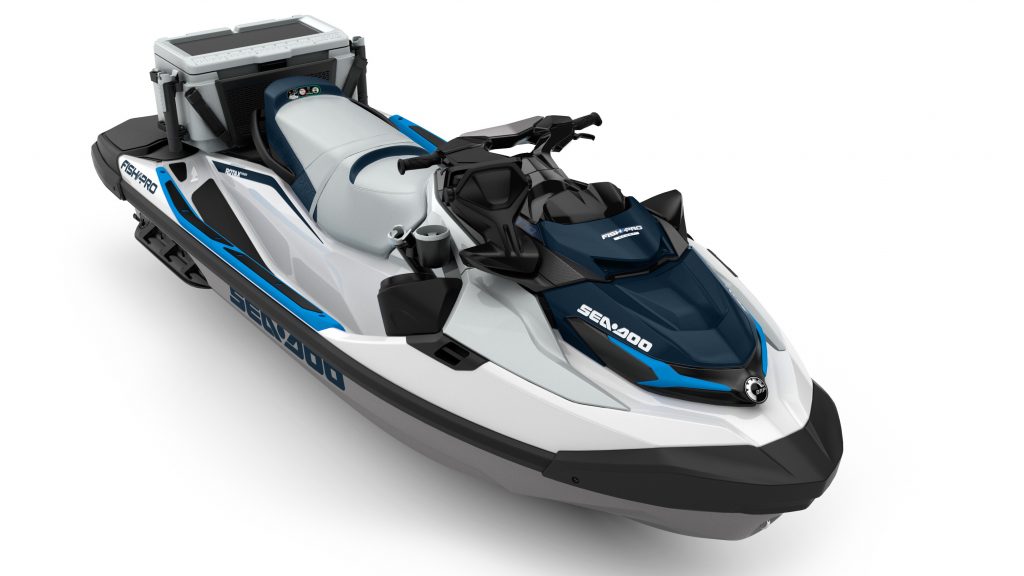
Pros: Genius design for fishing enthusiasts or anyone who wants to use the cooler box for a picnic. The Fish Pro is an adaptation of the clever Sea-Doo ST3 hull. It has a comfortable riding position, and a large rear deck extension for even more optional accessories. Trolling mode enables ultra-low speed cruising.
Cons: The large footwells can fill with water and make the craft unstable (fixed with a quick blast of the throttle). The ST3 hull is pretty good in medium to rough chop but its more upright nose means it ‘bow hunts’ in cross-chop. Not as good as the Yamaha FX in really rough conditions, not as agile as the Yamaha FX at low speeds in smooth conditions.
MORE: Buying a used Jet Ski? Here’s what to look for
MORE: When will the 2022 Jet Skis arrive in Australia?
MORE: 2022 Sea-Doo prices and model changes
MORE: 2022 Yamaha WaveRunner prices and model changes
MORE: 2021 Kawasaki prices and model changes
MORE: Follow us on Facebook



